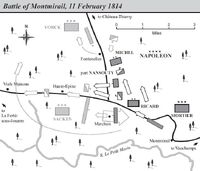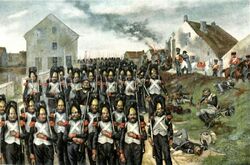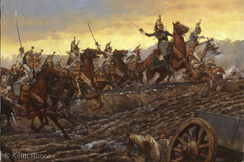| Battle of Montmirail | |
|---|---|
 The Battle of Montmirail | |
| Information | |
| Location | Montmirail |
| Date | 11 February 1814 |
| War | War of the Sixth Coalition; 1814 Campaign in France |
| Outcome | French victory |
| Belligerents | |
| Commanders | |
| Napoleon I | Fabian Wilhelm von Osten-Sacken
Ludwig Yorck von Wartenburg |
| Strength | |
| 20,000 | 36,000
|
| Casualties | |
| 2,000 | 4,000
|
The Battle of Montmirail was fought on the 11th of February 1814, the very next day after Napoleon's victory at Champaubert. It was fought by Napoleon to capitilise on the victory he had won over General Olsufiev's Russian corps the previous day, and, by moving quickly, to retain the initiatve he had won by placing himself astride the Army of Silesia's communications.
Prelude
After his destruction of General Olsufiev's Russian corps at the Battle of Champaubert, Napoleon now occupied the perfect 'Central Position' and was ideally placed to move either against Generals Yorck and Sacken to the west who were chasing Marshal MacDonald, or to move against Marshal Blucher, the 'Old Forward' himself, who lie to his other side to the east.
Napoleon chose to move against Sacken's Russian corps and Yorck's Prussians in the west, since he surmised that if he dashed at Blucher, the old Prussian would merely withdraw before him upon his supply lines and his blow would fall upon empty air, whilst Sacken and Yorck meanwhile would simply make good their escape over the River Marne. In that event, his initiative he had won would be lost.
" I shall march to defeat Sacken at Montmirail tommorow," Napoleon confided. Therefore, having made his decision to eliminate the enemy forces lying west, Napoleon ordered Marshal Marmont with 4, 000 men to stay put at Champaubert to watch Blucher. To Macdonald, retreating towards Meaux, he instructed to hold fast and to resume the offensive, moving to capture Chateau Thierry and deny the enemy an escape route over the Marne. Sending orders to both Oudinot and Mortier to be ready to march to the sound of the guns, Napoleon then led the rest of his army through the night and the deep mud to Montmirail.
Blucher meanwhile had recoiled backwards, sending out orders to both Sacken and Yorck to concentrate as soon as possible at Montmirail in order to attempt to force a way through Napoleon's forces and reestablish contact with him.
Sacken, with 18,000 men and 90 guns, obeying Blucher's orders to the letter was retracing his steps back to Montmirail, as rain fell from a heavy, dark sky. By 10:30 am on the 11th, he reached the village of Viels-Maison,s, six miles west of Montmirail and his cavalry advance guard was able to confirm that Montmirail lying ahead was held by the French. Still perservering eastwards and hoping to link up with Yorck's Prussians, Sacken ran into ever increasing resistance as his army approached the village of Marchais and it was evident a major battle would have to be fought in order to fight his way through.
Napoleon, owing to the attrocious weather which had made movement over the countryside difficult, had just 10,500 troops with him and 36 guns with which to halt Sacken's thrust eastwards. He knew he was taking a very large gamble against such odds, for he was outnumbered by almost 8,000 men. In addition, should Yorck march to the sound of the guns as he expected him too, the odds would likely tip decisively in the Allies favour. He hoped that Mortier would arrive in time with reinforcements to readress the balance, but owing to the weather he was still doubtful if they could arrive in time. A defeat for Napoleon could not be discounted at this time, but with France in the hour of crisis, there was a need for decisive action.
To rally public morale, he had already sent off a exaggerated bulletin to Paris claiming a major victory at Champaubert, and adding "If fortune favours us again as it did today, ecverything will be changed in the flicker of an eyelid"
Battle

Map of the battle.
By the late morning, the battle escalated as Sacken ordered his divisions to hold Marchais about 1000 yards south of the road as well as the farmhouse of Les Grenaux about 300 yards north of it, next to the road. His cavalry about 2,000 strong was ordered to take up positions north of the farmhouse in anticipation of Yorck's Prussians arriving at Fontenelle.
Napoleon had also posted detachments towards Fonntenelle to watch for Yorck, hoping for reinforcements of his own to arrrive as he himself could only hold his own and fight a defensive battle, launching only limited counterattacks towards Marchais.
But the early afternoon, Ricards 1,800 conscripts had been ousted from Marchais as Sacken launched a strong attack. French patrols posted to the north of the road were also reporting the approach of Yorck's advance Guard. towarrds Fontenelles. It was a critical time for the French at this stage of the battle and Napoleon dared not launch an attack towards the centre of the Allied line at the farmhouse of Les Grenaux as he would have liked for he was worried that Yorck's advance guard might launch a strong flank attack on him, whilst he held nothing in reserve to ward of the attack. Fortunately for Napoleon, Yorck was approaching with great caution, evidently unwilling to become sucked into a major battle and he came with only a fraction of his corps; 4,000 men under Pirch.
The battle continued admist heavy showers of rain. From Le Tremblay Ricard's outnumbered conscripts unethusiatically counterattacked Marchias and were thrown out and this time the Russians pressed on and secured a foothold in Le Tremblay too.

The Old Guard marches into battle at Montmirail
Napoleon watched and waited for Mortier to arrive so he could switch to the defensive, but the appalling weather appeared to ruin his plans. He would just have to hold his own and hope. And then, in the distance a long line of bearskins of his Old Guard were marching into view. Napoleon was elated, and now assured of the means to swing the initiative his way, he at once ordered forward six battalions of the Old Guard with Ney, the 'Bravest of thge Brave' at their head. The irresistable Guard plunged forward with their customary 'elan' to storm the Farmhouse of Les Grenaux, overwhelming Sacken's Russian defenders with relative ease. Sacken frantically launched cavalry attacks in a vainb attempt to hold his line, but the Old Guard, with the assistance of part of the Guard cavalry repulsed them, rolling the Russian line backwards. Pirch at Fontenelle, witnessing his ally in difficulty atempted to come forwrd to help his stricken ally as Sacken, the centre of his line ruptured at Le Grenaux, now wavered on the verge of collapse It was too late. Napoleon had now been reinforced to 20,000 men, and with the enemy's centre ruptured, he now he launched another attack on the stricken Russian line at Marchais with two battalions Friant's Old Guard under Marshal Lefebvre, supported by the remainder of Ricard's heavily depleted conscripts who bolstered by the Guards presence marched forward crying "Vive le Empereur!" The Russians had had enough and broke

The Empresses Dragoons of the Guard charge
As the Russian's turned tail and ran, the battle entered it's final stages and it became a pursuit, as relentless French cavalry charges hounded the enemy. At Fontenelles, Mortier led a furious attack against the Prussians in order to break through to gain the Chateau Thierry road, which might have isolated Sacken's withdrawing army. But Pirch, himself seriously wounded, clung desperately on to deny the French the means, and the road remained barred.
By nightfall Napoleon's Polish lancers had fought their way as far as Viels Maisons's to the west, where Sacken's Russians's fought a confused rearguard struggle to maintain a corridor of retreat northwards to link up with Yorck's Prussians at Chateau Thierry.
As it was, Sacken and Yorck left 4,000 casualties on the field at Montmirail, and Yorck had suffered a greater percentage of losses amongst his soldiers than had Sacken, Pirch losing a quarter of his strength, reflecting the ferocity of the fighting at Fontenelles. Napoleon had won his second victory in two days with a mere 2,000 casualties.
Conclusion
The French victory at Montmirail had been won by Napoleon's masterly control of the battle from beginning to end. Outnumbered by his two foes, Napoleon had dominated his opponents and imposed his will over the field against an army that was well led and by no means defiecient in courage and fighting skill. Above all, it was a triumph for the Old Guard, which Napoleon recognized when he attributed his victory to the sterling performnce of his Guard, " Who had done more than can be expected of men." But it was also a victory for Ricard's young conscript's who had suffered grievious losses in the bitter fighting around Marchias. Before the battle, The Old Guard had remained aloof towards them, but now these 'brave lads' who had marched side by side with them into the cauldron of battle, were feted by the 'old grumblers' who cheered them and adopted them, knowing they could be relied upon.
Napoleon claimed afterwards that "These last two days have entirely altered the state of affairs" In his assesment, it was indeed nothing more than the truth.
For Sacken and Yorck retreating to Chateau Thierry, it had been a remarkable defeat in anything in which they had simply beeen outgeneralled by their opponent. In his caution to approach the battlefeild in strength, Yorck revealed his awe of Napoleon's prowess in battle, which in turn had sown the seeds of the allied defeat, since if Yorck had committed himself in strength, the outcome might have been very different. However, Yorck's assistance, limited as it was saved Sacken from complete destruction, and enabled many Russians to escape.
At the news of this second defeat, Blucher's former confidence since his wild optimism since La-Rothiere evaporated, and he lost no time in ordering the commencement of a general retreat towards Rhiems.